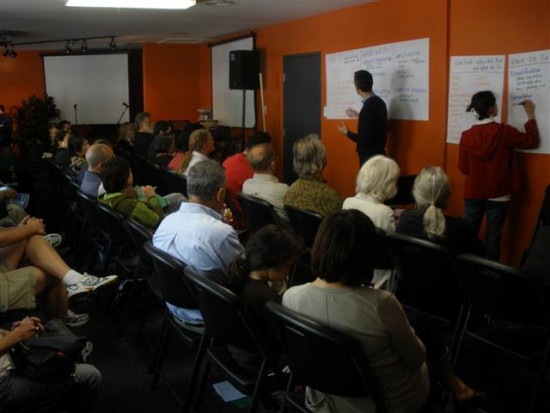 About 50 community members attended the Council District 13 Los Angeles Neighborhood Dreams Initiative (LAND) Summit for the Echo Park and Historic Filipinotown neighborhoods on Saturday morning at Echo Park’s Angelus Temple (Previous posts for the Hollywood and Atwater Village summits here). The three-hour community visioning workshop, which took place in a youth center on the church campus, attracted mostly neighborhood activists, especially from groups like the Greater Echo Park Elysian Neighborhood Council and the Echo Park Improvement Association, but a good number of residents and folks from the business sector were in attendance as well.
About 50 community members attended the Council District 13 Los Angeles Neighborhood Dreams Initiative (LAND) Summit for the Echo Park and Historic Filipinotown neighborhoods on Saturday morning at Echo Park’s Angelus Temple (Previous posts for the Hollywood and Atwater Village summits here). The three-hour community visioning workshop, which took place in a youth center on the church campus, attracted mostly neighborhood activists, especially from groups like the Greater Echo Park Elysian Neighborhood Council and the Echo Park Improvement Association, but a good number of residents and folks from the business sector were in attendance as well.
Aside from having worked in Historic Filipinotown for a number of years, having family and cultural ties to the community (my parents met each other there in the late 1960s), owing Echo Park to my community organizing origins and being a community geek in general, I actually attended the Summit in a formal capacity; the council office hired me to do social media coverage of the event; I was on hand to Tweet observations and outcomes from the Summit.
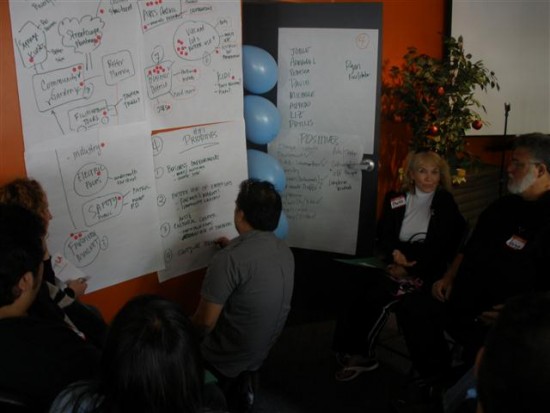
CD13 Historic Filipinotown Field Deputy Ryan Carpio facilitates one of the breakout groups for the neighborhood.
Although I attended the meeting nearly halfway through due to taking care of my Cahuenga Library cleanup duties earlier (they were already aware of this), I walked in to a session that was bustling with loud and lively conversation; it was as though the energy of some 50 overlapping ideas body-slammed me as I entered the orange-colored room, which was great. There were four groups formed, generally split to two per community, although many issues overlapped.
This was a unique meeting in that there were two adjacent, yet uniquely distinct communities being covered here: Echo Park, one of the City’s oldest “suburbs,” according to the Summit’s participants, is a paradoxically quiet neighborhood that’s just a stone’s throw from the bustle of Downtown Los Angeles. Largely due to its history and topography (it boasts some of the steepest streets in L.A.), it is home to very active community organizations centered around its residential areas, arts districts, retail corridors (generally, Sunset and Glendale boulevards) and the eponymous park. In contrast, Historic Filipinotown, formally a younger community (it was designated by the City in 2002), centered around arts and culture with a number of longtime residents, some of whom describe their neighborhood as “off the grid” in relation to neighborhood recognition by most people in the City.
I asked a couple of the participants what sorts of ideas they brought up. Echo Park resident Susan Borden, a longtime activist with the EPIA – and was one of my early community organizing mentors when I wanted to duplicate Echo Park’s cleanup efforts in my neighborhood (which was at the time largely undefined, and thus forced me to come up with the “East Hollywood moniker) in the mid 1990s – said she wanted to see things like pedestrian-oriented street improvements, and the beautification of her community’s business corridors designed with the community’s identity in mind.
Joselyn Geaga Rosenthal, a longtime Historic Filipinotown activist and owner of the Remy’s On Temple art gallery suggested altering the purpose of the recycling center on Temple Street to also offer health resources, mainly to benefit the low-income and homeless who frequent the facility.
I, too, had my own ideas for the neighborhood, namely Historic Filipinotown, but I wasn’t able to arrive in time to participate in the breakout groups. I would like to see an integrated pedestrian-oriented plan for the Temple and Beverly corridors, which would hopefully attract more restaurants in the area. I’m not a fan of most of the current Filipino restaurants in Historic Filipinotown (although there have been a couple of good ones that have only sprung up recently), it seems what is missing from Hi-Fi is a more concentrated commercial/cultural corridor, much like the 6-block-long Thai Town in my East Hollywood stomping grounds. I also would love to see a farmer’s market in HFT, namely under the Beverly Blvd. flyover bridge on the eastern edge of the neighborhood (more on this in a future post…). Fortunately, a number of people already listed “farmer’s market” in their breakout group’s litany of community priorities. As someone who frequents the one in my neighborhood, I believe every community deserves their own farmer’s market.
Towards the end of the session, Garcetti summarized Historic Filipinotown’s wishlist in the following categories:
– Identity/Marketing (Community gateway landmark, advertising/promotion of community, tours, signage)
– Beautification (Clean-up events, streetscape projects, converting empty lots into farmer’s markets (Yesss!) and community garden sites).
– Economic Development (Bringing businesses to empty storefronts and lots, jobs, attracting businesses and giving incentives to new businesses)
– Arts/Culture (Theatres and culture programs)
– Safety (More police/security patrols, youth activities (which were also linked to arts/culture and job development)
– Capacity Building (Community involvement, community groups)
And Echo Park’s wishlist went like this:
– Beautification (Trash cans/Big Belly, a streetscape plan, tree planting and care, street furniture, Glendale Blvd corridor beautification, conversion of empty lots into community gardens and pocket parks)
– Transportation (Walkability improvements, bike paths, reconfiguration of the 2 Freeway terminus)
– Youth (Park facilities and youth programs)
– Community Capacity (Creating connections)
Like the previous LAND summits, there will be a steering committee — actually one committee each for Echo Park and HFT (I plan to serve on the latter).
It would be interesting to see the energy of the room’s participants translate into results as these steering committees work with the council office on these projects.
But that ain’t all…next comes Part 2 of the LAND Double-Whammy, this time in my home and native land of East Hollywood.
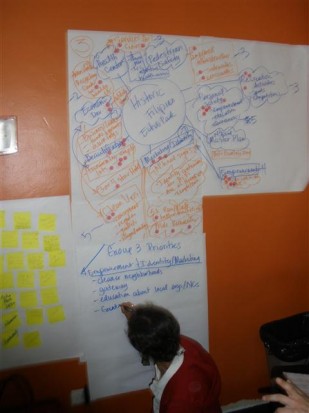
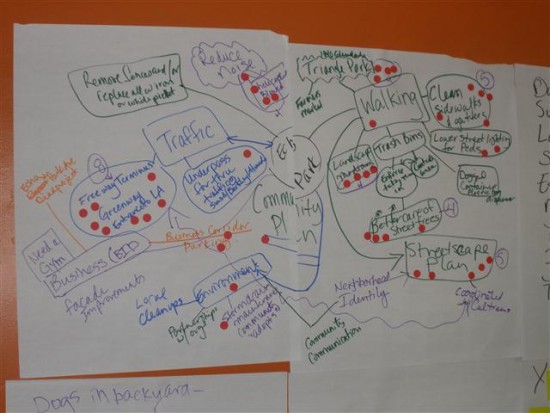
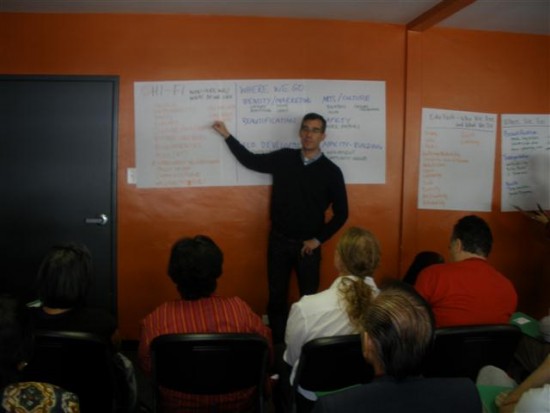
This was very fun and we had a lot of good ideas but how much has gotten done?